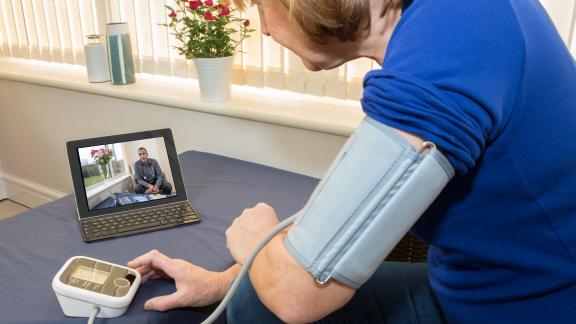Hospital at Home: Sussex Community NHS Foundation Trust

Patients who are recovering from COVID-19 and need ongoing oxygen therapy can now be cared for at home rather than in hospital, thanks to remote health monitoring and use of special devices via the Hospital at Home initiative.
What the organisation did
A partnership between Brighton and Sussex University Hospitals NHS Trust (BSUH) and Sussex Community NHS Foundation Trust (SCFT) led to the creation of a new standard operating procedure for patients who are recovering from COVID-19. Patients are discharged to the care of specialist community services with an electronic device that will remotely track their vital signs and ensure they are in touch with a clinician at all times. This enabled patients to return home faster and recover with their families, rather than remaining in a hospital setting.
Specialist community nurses monitored the progress of patients at home using a remote monitoring app (Current Health) to measure vital signs 24 hours a day, providing trends data to help support decision making.
The app also facilitated the specialist community nurses to video call patients on a tablet provided for patient consultations.
Results and benefits
This innovation has supported rapid discharge of patients post-COVID-19, enabling the Hospital at Home team to monitor them safely while they are recovering in their own environment.
Digital solutions were put in place rapidly, as was the agreement of a new standard operating procedure between the two trusts.
The digital technology has been used not only to provide a remote service to monitor patients, but also to communicate effectively with those responsible for their care.
It has also supported an increase in staff availability and capacity, as staff are not traveling to see patients face to face, so they have more time available for video consultations. The reduction in patient and staff travel for face-to-face appointments also has benefits for the environment too, reducing the carbon footprint.
The video calling facility has meant issues are picked up immediately with patients, and 24-hour monitoring enables enhanced diagnosis and care management.
Feedback from patients is that they feel that they are always being looked after, with a key point of contact clearly known.
Challenges and lessons
The new technology, although in place rapidly, took some time for staff to adjust to, and some technical ‘gremlins’ caused issues initially.
Working in a new way has led to challenges for some staff. For example, rolling out staff training quickly, and managing staff perceptions that patients will not be able to access the devices or use the app.
Some staff also felt that they lost the human factor by not being in same room for staff / patient interactions.
The remote way of working also meant that there was no opportunity to undertake other environmental assessments that would usually be carried out in patients’ own surroundings.
What is needed to sustain the innovation
- Resilience from all involved.
- Taking a risk to keep going with the new innovation.
- Reprioritise what is needed and how it could be delivered – focus on the patient care requirements first and then develop the operational solution.
- Continuation of the funding for the Current Health app.
- Acknowledgement that up-front investment in a digital solution is needed for longer term and more sustainable benefits.
Contact details for more information
Michelle Eades, Head of Strategic Development, Sussex Community NHS Foundation Trust
michelle.eades@nhs.net



